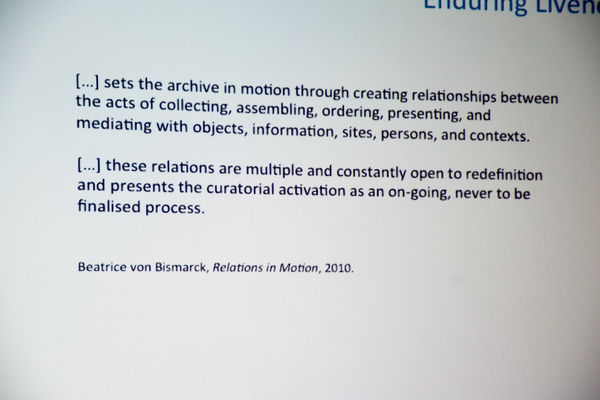Enduring Liveness. Towards building Networks of Care
(02.11.2018)
https://hdl.handle.net/20.500.11806/qr/ade_Dekker

The key functions of a museum are collecting, preserving and presenting, and informing the public about culture and art. Performance art has been notoriously difficult for museums to handle. Despite the "easy" presentation, the non-materiality of the artform challenges a museum’s conventional methods and practices. At the same time, artists and audience documentation of live events has become ubiquitous and circulates through multiple layers of hardware, software and code into different cultural and social corners. Seeing documentation merely as capturing an event fails to recognize the transformative potential of documentation as event. In other words, being informed and regulated by invisible systems and algorithms, from its creation to its dispersal, documentation is not merely a means to mediate something but can become co-constitutive of the event.
Looking at documentation as a performative process points to two interesting perspectives. On the one hand, it signals that the function of documentation might have changed, at times becoming something other than merely a representation of a work or a specific moment. As well that it is created by different people and endures through human and machinic interventions in multiple ways.
This shows that the creation of documentation is no longer the sole expertise of the archival institute or the museum. The fact that a combination of various audience members and non-human entities will become actors in the production of new content and value for the museum will impact their relationship with the museum. By looking at examples in which documentation expands on the conventional methods of capturing live events, I will critically address the traditional authority of the museum as creator of documentation in favour of the concept of a “network of care”. Such a network consists of different stakeholders and caretakers (human and machinic) who use decentralised systems to create, distribute and potentially preserve cultural heritage. In this presentation, and based on the examples, I explore some of the main characteristics that are needed in order for a “network of care” to succeed outside of an institutional framework or to become effective as a tool for transformation.

place: Kunstmuseum Bern

| Rights: | https://creativecommons.org/licenses/by/4.0/ |
| Key: | 5DGJNZVW |
| DateAdded: | 2019-04-14T10:28:01Z |
| ShortTitle: | Liveness aushalten. Soziale/fürsorgliche Netzwerke bauen |
| Language: | Deutsch |
| DateModified: | 2021-10-13T10:40:14Z |


















